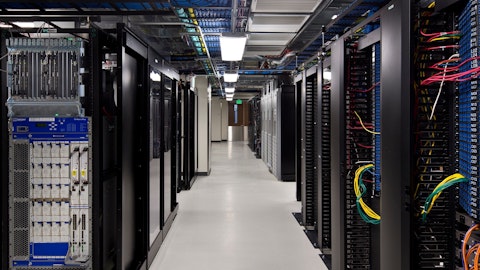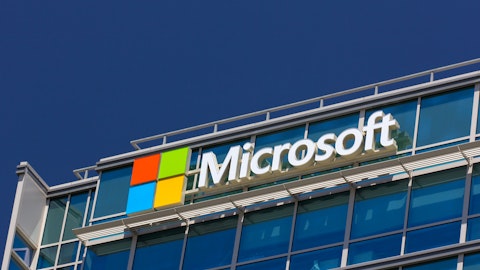Oracle Corporation (NYSE:ORCL) Q2 2024 Earnings Call Transcript December 11, 2023
Oracle Corporation beats earnings expectations. Reported EPS is $1.34, expectations were $1.32.
Operator: Good afternoon. My name is Emma, and I will be your conference operator today. At this time, I would like to welcome everyone to the Oracle Corporation’s Second Quarter 2024 Earnings Conference Call. All lines have been placed on mute to prevent any background noise. After the speaker’s remarks, there will be a question-and-answer session. [Operator Instructions]. Ken Bond, you may begin your conference.
Ken Bond: Thank you, Emma. Good afternoon, everyone, and welcome to Oracle’s second quarter fiscal year 2024 earnings conference call. A copy of the press release and financial tables, which includes a GAAP to non-GAAP reconciliation and other supplemental financial information can be viewed and downloaded from our Investor Relations website. Additionally, a list of many customers who purchased Oracle Cloud services or went live on Oracle Cloud recently will be available from our Investor Relations website. On the call today, our Chairman and Chief Technology Officer, Larry Ellison, and Chief Executive Officer, Safra Catz. As a reminder, today’s discussion will include forward-looking statements, including predictions, expectations, estimates, or other information that might be considered forward-looking.
Throughout today’s discussion, we will present some important factors relating to our business, which may potentially affect these forward-looking statements. These forward-looking statements are also subject to risks and uncertainties that may cause actual results to differ materially from statements being made today. As a result, we caution you against placing undue reliance on these forward-looking statements, and we encourage you to review our most recent reports, including our 10-K and 10-Q, and any applicable amendments for a complete discussion of these factors and other risks that may affect our future results or the market price of our stock. And finally, we are not obligating ourselves to revise our results or these forward-looking statements in light of new information or future events.
Before taking questions, we’ll begin with a few prepared remarks. And with that, I’d like to turn the call over to Safra.
Safra Catz: Thanks, Ken, and good afternoon, everyone. We had another great quarter. When you look at the top of our financial results table, a few things are very clear. The largest number, cloud services and license support, is now 74% of the revenue, and it’s recurring revenue, and it’s the one growing by $1 billion this quarter. The smaller numbers, which are not recurring, now account for only 26%. This is exactly what we told you would happen, and it’s happening. And as this continues, total revenue growth will accelerate every year. To that point, OCI is now one of the clear drivers of our acceleration. Imagine just three years ago, OCI was rarely, if ever, mentioned as a viable hyperscale alternative. Of course, we knew what we had built and we kept talking about it and we knew it was only a matter of time.
And now, more industry analysts are catching on to what customers are choosing. For example, just last week, we were recognized as a leader in the 2023 Gartner Magic Quadrant for Strategic Cloud Platform Services. Our financial results reflect that customers have figured out that by moving to OCI, they really can get more while paying less. On top of that, we are now the default choice for AI workloads given our unique differentiation and price performance capabilities. Why specifically are they coming to Oracle Cloud Infrastructure? Well, it’s a combination of several things. Creating the second generation cloud enabled us to build a much better, more scalable, and more efficient cloud. We understood the limitations of the first generation and engineered very differently.
Second, we know what it takes to run at enterprise scale, performance and security better than, I say, anyone else. Our 45-year history as the leading enterprise software company gives us unique knowledge of what exactly is required to run mission critical systems. Third, we recognize that customers need deployment flexibility rather than just offer public cloud services like our competitors, we are the only vendor which also offers dedicated cloud to customer, dedicated region, sovereign clouds, and Alloy, our partner clouds. And then finally, our belief in the importance of multi-cloud offerings will be industry changing as these collaborations roll out. With all this success and exploding demand, we are working as quickly as we can to get the cloud capacity built out.
Now, to the Q2 results. With total revenue at the midpoint of my constant currency guidance and the EPS at the high end of guidance. Now, as a reminder, currency was 1 point less helpful than when we gave guidance three months ago. Total cloud revenue, that’s SaaS plus IaaS, excluding Cerner, was $4.1 billion, up 25%. Including Cerner, total cloud revenue was up 24% at $4.8 billion, with IaaS revenue at $1.6 billion, up 50%, and SaaS revenue of $3.2 billion, up 14%. Total cloud services and license support revenue for the quarter was $9.6 billion, up 11%, driven again by our strategic cloud applications, autonomous database, and our Gen 2 OCI. Application subscription revenues, which includes support, were $4.5 billion, up 9%. Our strategic back office SaaS applications now have an annualized revenue of $7.1 billion and we’re up 19%.
Infrastructure subscription revenues, which includes license support, were $5.2 billion, up 12%. Infrastructure cloud services revenue was up 50%. Excluding legacy hosting services, Gen 2 infrastructure cloud services revenue grew 55%, with an annualized revenue of $6 billion. OCI consumption revenue was up 71%. Database subscription revenues, which includes database license support, were up 4%, highlighted by Exadata database cloud services revenue, which was up 40%, and autonomous database up 26%. Very importantly, as on-premise databases migrate to the cloud, we expect these cloud database services will be the third leg of revenue growth alongside strategic SaaS and Gen 2 OCI. Software license revenues were $1.2 billion, down 19% in a tough comparison to last year where it was up 23%.
So all in, total revenues for the quarter were $12.9 billion, up 4% including Cerner, actually up 6% excluding Cerner. Now shifting to margins, the gross margin for cloud services and license support was 78%. This is because of the mix between support and cloud in which cloud is growing much faster than support. Support and SaaS margins are consistent with last year, while IaaS gross margins improved substantially. While we continue to build data center capacity, gross margins go higher as these new cloud regions fill up. We monitor these expenses carefully to ensure gross margin percentages expand as we scale. To this point, the gross profit dollars of cloud services and license support grew 10% in Q2. Non-GAAP operating income was $5.5 billion, up 7% from last year.

The operating margin was 43%, up from 41% last year. As we continue to benefit from economies of scale in the cloud and drive Cerner profitability to Oracle standards, we will not only continue to grow operating income, but we will also expand the operating margin. The non-GAAP tax rate for the quarter was 19% and non-GAAP EPS was $1.34 in USD, up 11% in USD, and up 9% in constant currency. GAAP EPS was $0.89 in USD. At quarter-end, we had nearly $8.7 billion in cash and marketable securities and the short-term deferred revenue balance was $8.9 billion, up 1%. Over the last four quarters, operating cash flow was $17 billion, up 13%. And free cash flow was $10.1 billion, up 20%. Capital expenditures were $6.9 billion over the same period as we continue to seek cash flow benefit from our cloud transformation.
Our remaining performance obligation, or RPO, is now over $65 billion, with the portion excluding Cerner up 11% in constant currency. We continue to sign large deals with many in the pipeline. Approximately 48% of total RPO is expected to be recognized as revenue over the next 12 months. CapEx was $1.1 billion in Q2 as we continue to build capacity for bookings and our customers’ growing needs. Given the enormity of our pipeline and backlog, I expect CapEx will be somewhere around $8 billion this fiscal year, meaning our second half CapEx will be considerably higher as we bring online more capacity. To that point, we now have 66 customer facing cloud regions live, with 45 public cloud regions around the world and another six being built. 12 of these public cloud regions interconnect with Azure and starting next year, customers will be able to run Oracle Database at Azure on OCI inside Azure.
We also have 10 dedicated regions live and 13 more planned, nine national security regions, and two EU sovereign regions live with increasing demand for more of each. And finally, we have seven Alloy cloud regions planned where Oracle partners become cloud providers offering customized cloud services alongside the Oracle Cloud. And of course, we also have so many, many, many clouded customer installations. The sizing flexibility and deployment optionality of our cloud regions continues to be advantages for us in the marketplace. Finally, as we’ve said before, we’re committed to returning value to our shareholders through technical innovation, strategic acquisition, stock repurchases, prudent use of debt, and a dividend. This quarter, we repurchased 4 million shares for a total of $450 million.
And in addition, we paid out dividends of $4.1 billion over the last 12 months. And the Board of Directors declared a quarterly dividend of $0.40 per share. Now let me turn to my guidance for Q3, which I will review, as always, on a non-GAAP basis. If currency exchange rates remain the same as they are now, currency should have little effect on total revenue and EPS. However, the actual currency impact may be different. So because of that, all the numbers I give you are the same for constant currency and USD. Total revenues, including Cerner, are expected to grow from 6% to 8%. Total revenues excluding Cerner are expected to grow from 8% to 10%. Total cloud revenue excluding Cerner is expected to grow from 26% to 28%. Non-GAAP EPS growth is expected to grow between 10% and 14% and be between $1.35 and $1.39.
My EPS guidance for Q3 assumes a base tax rate of 19%. However, one-time tax events could cause actual tax rates to vary. Finally, I remain firmly committed to our fiscal ‘26 financial goals for revenue, operating margins, and EPS growth. And with that, let me turn it over to Larry for his comments.
Larry Ellison: Thank you, Safra. The demand for Oracle’s Cloud Infrastructure and Generative AI is consistently increasing quarter after quarter. Oracle’s total remaining performance obligations, or RPO, has now reached $65 billion, slightly more than our annual revenue. In response to this sharply increasing demand, Oracle is in the process of expanding 66 of our existing cloud data centers and building 100 new cloud data centers. We have to build 100 additional cloud data centers because there are billions of dollars more in contracted demand than we currently can supply. Cloud Infrastructure demand is huge and growing at an unprecedented rate. In the next few weeks, we expect to sign a couple more billion dollar Cloud Infrastructure contracts.
Gartner recently named Oracle OCI as a leader in cloud platform and infrastructure services. The demand for Cloud Infrastructure services and new Oracle cloud data centers is broad-based, driven not only by Generative AI customers, but also by nation states buying sovereign Oracle cloud data centers, plus large banks, telecommunications companies, and industrial companies, buying dedicated cloud data centers, dedicated Oracle cloud data centers, and perhaps most interestingly, demand from other hyperscalers and other cloud service providers, co-locating and connecting their clouds with Oracle cloud data centers. Customers don’t want clouds to be walled gardens. In the next few months, we will turn on 20 new Oracle cloud data centers, co-located with and connected to Microsoft Azure as a part of our joint multi-cloud initiative.
These 20 new multi-cloud data centers will house over 2,000 full racks of Exadata database machines designed to meet pent-up demand for the Oracle cloud database. We’re able to build new data centers rapidly and operate them inexpensively because all of our data centers are architecturally identical, highly automated, with an identical high-performance RDMA network, autonomous services, and applications. Oracle cloud data centers vary only by scale. Again, several nation states have ordered multiple sovereign data centers to be built within their country so that they can move their government, healthcare, and commercial workloads to the Oracle cloud. These new countries include Japan, Italy, Saudi Arabia, Bangladesh, New Zealand, and others.
Some of the world’s largest banks, telecommunications and industrial companies, have also contracted with us to build Oracle cloud data centers dedicated entirely to them so that they can migrate their workloads to an Oracle cloud data center. These companies include Nomura, Vodafone, Telecom Italia Mobile, Saudi Telecom, a huge Korean conglomerate, and a huge US defense contractor. These are but a few examples that demonstrate the diversity of the growing demand for Oracle’s highly differentiated Gen2 cloud infrastructure and data center technology. Back to you, Ken.
Ken Bond: Thank you, Larry. Emma, if we could please poll the audience for questions.
See also 20 Best Vodkas for a Moscow Mule and Ark Invest Stock Portfolio: 16 Biggest Positions.
Q&A Session
Follow Oracle Corp (NYSE:ORCL)
Follow Oracle Corp (NYSE:ORCL)
Operator: Thank you. [Operator Instructions] Your first question today comes from the line of Ben Reitzes with Melius Research. Your line is open.
Ben Reitzes: Hey, thanks a lot. It’s great to be speaking with you this afternoon. Do you mind going through your thoughts on the OCI trajectory from here and how you feel backlog will play out into revenue? And perhaps you can comment also, is the acceleration potential that you guided for due to getting more GPUs and more AI backlog moving into revenue? Thanks a lot.
Safra Catz: Larry, you want me to take it or you?
Larry Ellison: No, either one, Safra, you tell me.
Safra Catz: How about I get started? So, where do we expect OCI to go from here? Frankly, the only limiting factor is our ability to get the data centers handed over and filled up fast enough. This quarter alone, we’re talking about hundreds of millions of dollars that we would have been able to recognize if our capacity was available. So the reality is, as we roll out and we’ve got just so many moving parts as you can hear from us, we have a lot of capacity coming online. And as you can see in my CapEx guidance, we expect OCI to just grow astronomically, frankly. It is the ideal infrastructure for so much use. And of course, also as more GPUs become available, and we can put those in, we have just a really unlimited amount of demand. Larry, I don’t know if you want to say anything else?
Larry Ellison: Yeah, well again, in the next few weeks, I mentioned we’re going to sign two additional contracts right around $1 billion each. I mean the backlog is growing astronomically. I think it’s the word Safra used and that’s accurate. There’s no reason why — OCI grew 50% this quarter. I think OCI is going to get much bigger and actually the growth rate will be above 50%, I believe, as these data centers come online. We think we can build a lot of these data centers very quickly. By the way, again, I emphasize it’s not just GenAI demand. There is huge pent-up cloud database demand. There is huge demand overseas for sovereign clouds, where people — governments haven’t been able to move their workloads. A lot of those are government Oracle workloads.
They haven’t been able to move their workloads to the cloud. I mean, there are literally, I don’t know, five, six, seven large companies in Japan that will be building at least two data centers, Oracle data centers each. So again, the demand is extraordinary. We can build the data centers relatively fast. And I expect the OCI growth rate to be over 50% for a few years.
Safra Catz: Yes, we’re not demand limited in any way right now.
Ben Reitzes: Thanks a lot, Safra and Larry. Appreciate it.
Operator: Your next question comes from the line of John DiFucci with Guggenheim. Your line is open.
John DiFucci: Thank you. Thanks for the question. Thanks Larry for the — and Safra, for those comments on the future OCI growth. So since Ben asked about the growth, and maybe I’ll take a step back on the other part of all this, and that’s the profit side. Per Larry’s comments, you’re building out a lot of capacity and Safra’s comments agree with that, with the CapEx growth. But Clay’s also spoken about the time it takes to build out those AI super clusters and I know that’s not the only AI workloads you’re doing, but that sounds like some pretty exciting stuff. And it takes time before you get revenue. I realize you’re also seeing ramp up of those what I’ll call core OCI deals like Uber, and you actually get revenue from them over time. But how should we think about cloud gross margins over time in this context with both those things? There’s a lot happening here.
Safra Catz: Yes, and I’m really glad you asked. I’m really glad you asked because one of the lines that we show you, even though I give you more detail, is I show you a number that is a mix of cloud and support. And obviously, support is extremely profitable because of the structure of the way it works, and because we are at such a large scale. But the reality is that our cloud businesses are also very profitable. Our SaaS cloud business is very profitable, and our IaaS, our OCI business, is improving profitability as it grows. And so the target gross margins for it are much higher than I think you expect because you’re probably comparing it to some of the more pure play cloud folks who somehow don’t end up making as much money in all of this.
As we grow, our gross margin percentage goes up. So yes, we make a lot of investments and we’ll be making a lot of investments, but our profitability continues to go up. Because once the day — the worst moment is at the moment where the data center is full of computers and you don’t have any tenants that first day, but that’s not actually how we work. Yes, we have the floor space, but we grow in pieces. Unlike some of the others that they have to do a full out build out and put everything there before they have a penny of revenue, that’s not how we work. We — and more and more of our — so we start small and build up and that allows us to match our spending with the revenues much better. And that’s because we have that engineering deployment flexibility that the first generation folks don’t have.
I don’t know, Larry, if you want to add anything to that?
Larry Ellison: Yeah I do. I think one thing is very important. We’re much more highly automated than the older data centers. So to give you an idea, Oracle Cloud — to run Oracle Cloud we have to keep track of all of our customers, how much they’re using. We have to have a variety of databases and applications that run the cloud. Those databases are all the autonomous database. We have no labor associated with those databases. It’s all completely automated. Our installations, when we bring up a new cloud, you plug it in and the process of bringing it up is largely automated. There aren’t lots and lots of people in the data center to bring it up, and there certainly aren’t lots and lots of people in the data center to run it every day.
We focus on autonomous services. Our Linux, our operating system is fully autonomous. There’s no labor associated with running it. There’s certainly labor associated with building the software, but not running the software, it doesn’t cost us more to run 100 data centers than it costs us to run 10 in terms of DBAs or people running Oracle Autonomous Linux. So we have a very different model than our old data centers or our competitors’ data centers. We can run these things, we can bring them up relatively quickly and we can run them very inexpensively and efficiently. One last thing about being autonomous, the fact that it’s automated, there are far fewer errors and there are far fewer security vulnerabilities because the system is completely self-driving.
John DiFucci: If I might, and Safra, go back to something you said, is it fair to assume that OCI gross margins have consistently grown over time, quarter to quarter?





